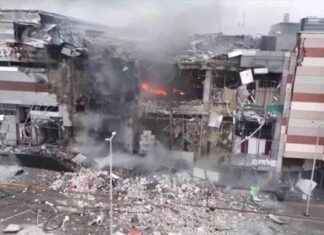Lena Nesterova recalls the moment her fate was sealed. It was February 24, 2005, 5:34 AM, when the first explosions in Kyiv, Ukraine, signaled the imminent Russian invasion.
She said that fear drove them to take only their daughter, dog and all documents. They left Kyiv with just the clothes on their backs.
“We have left everything. Nesterova added that we have no clothes or anything. “And we don’t know what the future holds.”
Margo, her 18-year old daughter, carried the toy Chihuahua dressed in a purple puffer in safety at a refugee camp in Siret, Romania.
According to the U.N.-affiliated Organization for Migration (Geneva), 1.45 million people fled Ukraine after Russia invaded Ukraine ten days ago. According to the U.N., the number of refugees could rise to 4 million to make it the worst crisis of this century.
Many have arrived in Poland and the other European Union countries where they are granted temporary protection and permits of residence. Others are making their way to other countries.
Over 100,000 people have reached Slovakia. Many plan to travel to the Czech Republic, which has a large Ukrainian community. Czech authorities have set up classes to teach thousands of children Ukrainian in the Czech Republic.
Every day hundreds of refugees arrive in Berlin, Germany’s capital. In Italy, more than 10,000 refugees arrived. 40% of them were children. The education ministry indicated plans to integrate them into schools.
Iryna Bogavchuk wanted lightness for her journey from Chernivtsi to Romania. It was a 40-kilometer (30 mile) trip across the Carpathian Mountains in south Ukraine. Her home city was alive with young people in better times. The university’s 19th-century architecture earned it a place on UNESCO’s World Heritage List.
She said, “I took my girl,” stroking her daughter asleep in her lap. “I hope that we will all be okay.”
Bogavchuk instead of bringing her belongings which would have been too heavy, she brought Polaroids which she scrambles for in her wallet. Happier times: Her daughter’s 10th Birthday; a photo of her and her husband. Ukrainian military men are prohibited from leaving the country. She broke down into tears, saying “I miss him.”
Ludmilla Nadzemovska travelled to Hungary via Kyiv, the Ukrainian capital. As U.S intelligence pointed out that Russia was planning to invade, she planned for the worst. She purchased traveling cages for her four cats one month in advance. After hearing that her neighbors were killed by Russian forces, she made the decision to leave.
She said that she wanted to return home, as she sat in Tiszabecs in Hungary, just across the border. “But my priority are my family and my pets.”
Nearby Moldova, a non EU nation nestled between Ukraine and Romania is home to hundreds of Roma families. They are welcomed at Chisinau’s sports arena.
Maria Cherepovskaia (50), walked the first 15 km from her Donetsk home, an eastern Russian-controlled enclave. To complete the remaining 900 kilometers to Moldova, she received assistance from others, including food and transport.
“We will remain here until the war is over.” She said that we don’t know where else to go. “They are bombing. They are bombing a lot.






